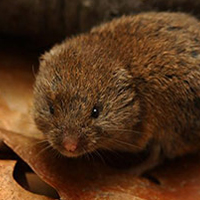Woodland vole
Scientific name: Microtus pinetorum

Cover photo credit: US Army Corps of Engineers
Status
Special Concern
“Special Concern” means the species lives in the wild in Ontario, is not endangered or threatened, but may become threatened or endangered due to a combination of biological characteristics and identified threats.
Date added to the Species at Risk in Ontario List
The Woodland Vole was already assessed as a species of special concern when the Endangered Species Act took effect in 2008.
What it looks like
The Woodland Vole is a grayish-brown rodent about 11 to 15 centimetres in length. Its body is suited to its partially subterranean habitat, with small eyes and ears largely hidden in the fur, a very short tail, blunt snout and enlarged front claws for digging. Their cheek teeth are adapted to chewing their herbivore diet of plant stems, bulbs and seeds. Rarely active above ground, Woodland Voles use a system of tunnels, covered runways and burrows to move about. They can remain active in winter, especially in years of good snow cover, when they will supplement their diet with tree bark.
Voles have short life spans of typically one year or less. In Ontario, the breeding season is confined to warmer weather between May and October. During this time, a pair may have three to five litters, with each litter usually numbering two to four pups.
Where it lives
In Ontario, the Woodland Vole lives in mature deciduous forest in the Carolinian region where there is a deep litter layer that allows it to burrow.
Where it’s been found in Ontario
The Woodland Vole is found throughout much of eastern North America, with a range that extends from southern Quebec, Ontario and Maine, south to northern Florida and Texas, and west to Michigan and Wisconsin. In Ontario, it is known to exist at 30 sites from the Municipality of Chatham-Kent and Lambton County, east to Haldimand County, and north to Halton Regional Municipality and the City of Hamilton. Because it spends most of its time below ground, this species is difficult to spot and may have been missed at other locations in the province.
View a larger version of this map (PDF)
What threatens it
In Ontario, the Woodland Vole is at the northern limit of its range and may never have been abundant here. Where it has been found in Ontario, the population densities are low. Potential threats include urban development, agricultural intensification, and forest fragmentation
Action we are taking
Special concern species do not receive species or habitat protection.
What you can do
Report a sighting
- Report a sighting of an endangered animal or plant to the Natural Heritage Information Centre. Photographs with specific locations or mapping coordinates are always helpful.
- The Carolinian forests of southern Ontario support an amazing diversity of plants and wildlife, including many species at risk. Carolinian Canada is working to help recover species at risk and their habitats. For more information, visit: www.carolinian.org/SpeciesHabitats.htm.
Volunteer
- Volunteer with your local nature club or provincial park to participate in surveys or stewardship work focused on species at risk.
Be a good steward
- Private land owners have a very important role to play in species recovery. You may be eligible for stewardship programs that support the protection and recovery of species at risk and their habitats.
Report illegal activity
- Report any illegal activity related to plants and wildlife to
1-877-TIP-SMNR (847-7667) .
Quick facts
- In the northeastern United States and Canada, the Woodland Vole is considered rare, whereas in its southern range it is abundant and regarded as a pest in some states.
- Woodland Voles are monogamous, and both males and females participate in caring for the young.
- Voles give a high-pitched sound to warn of danger.
